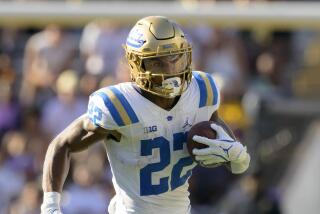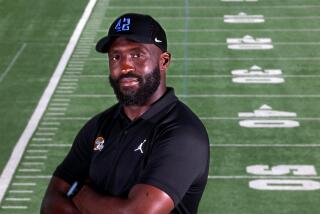A GROUNDSWELL : UCLA Has Run Into a Problem: 3 Good Backs
It hasn’t taken long for Brian Brown to stir up a tailback controversy at UCLA.
In his first two games since returning to the lineup after missing five games with a hamstring injury, the sophomore from Gardena High has shown himself to be more versatile and a better receiver than Eric Ball, a fifth-year senior and stronger inside runner who carried the load in Brown’s absence.
And then, of course, there is freshman Shawn Wills, whose average of 7.4 yards a carry is better than either Brown’s or Ball’s.
Actually, controversy may be too strong a word in this case.
Call it a tailback quandary.
Coach Terry Donahue hasn’t figured out how to use all of them.
As Ball put it: “The way the rotation is going now, it’s hard to get a fix on what’s happening.”
It used to be so simple.
While Brown recuperated from an injury in preseason drills last August, Ball was the starter and the focal point of the running game. And Wills, the rookie, knew his place. His role, as the only true freshman playing for the Bruins this season, was to spell the veteran Ball.
Ball rolled along, gaining more than 100 yards in each of UCLA’s first four games, including a season-high 148 against Nebraska. And Wills showed flashes of brilliance, making a spectacular 50-yard touchdown run against Nebraska that was one of the highlights of the Bruins’ 41-28 victory.
But, since the return of Brown 2 weeks ago, Wills’ playing time has been drastically reduced.
And Ball’s production had started to slip even before Brown returned. Last week, he looked lost at times, twice running into quarterback Troy Aikman on simple handoffs and gaining only 10 yards in 11 carries in the Bruins’ 24-3 victory over Arizona.
Meanwhile, Brown has been brought along slowly. He has carried 14 times for 65 yards and has caught 6 passes for 48 yards.
With Ball playing his worst game of the season, the Bruin running game struggled last week, gaining only 90 yards in 36 carries.
“Basically, the running game was the absolute pits, and it shouldn’t have been,” Donahue said. “Arizona has a good run defense, but not that good. That’s the same team that gave up (232) yards rushing to USC.”
At the time of his injury, Brown was said to be locked in a spirited battle with Ball for the starting tailback position.
Could he still displace Ball at this point in the season?
“If Eric keeps going the wrong way, Brian will be a starter for sure,” Donahue said, referring to Ball’s miscues against Arizona.
Not foreseeing that as a possibility, Donahue also said: “I don’t know if we’ll have a starter, per se, at tailback. Eric Ball will start the game, but the other two tailbacks will see action. How much and when, I’m not sure.”
Donahue seemed to have settled on a 2-man rotation against Arizona, but Wills then came on in the fourth quarter and gained 36 yards in 3 carries, including a 29-yard run in his first carry.
Said Donahue: “When he does that, you say to yourself, ‘Why didn’t I play him earlier?’ But it’s not like Brian Brown didn’t do some things, too. If he played the whole game and carried 30 times, it might have been different.”
Donahue understandably feels a certain loyalty toward Ball, who was the player of the game in the 1986 Rose Bowl, but was injured much of the next 2 seasons.
“He carried the team while Brian Brown was hurt,” Donahue said.
Still, Donahue seems to go out of his way to praise Brown.
What he finds particularly intriguing is Brown’s versatility. Several times against Arizona, the 5-foot 9-inch, 185-pound Brown lined up as a flanker.
“The problem we have is, if we want to do certain things, we’re clearly better off doing them with Brian Brown,” Donahue said. “He can do certain things as a receiver that add to our offensive production.
“And yet, I’m not sure we’re doing Eric Ball any favors by bringing him in and out of the game. There’s a real argument that we ought to let him play for 3 or 4 series before we bring him out.”
Also, certain situations call for the more powerful Ball, who is 6-1 and weighs 216 pounds.
While praising Brown’s ability to avoid bump coverage by using his quickness in running pass routes, Donahue said: “Eric couldn’t do that and yet, when we went for it on 4th and 1 (against Arizona), that isn’t the time you want Brian Brown in the game.
“I’ve seen him dive over a pile and come out the same way, heading in the wrong direction. I’ve seen him spun around like a top.”
So, it’s a matter of picking the right spots for Ball and Brown, but also not forgetting Wills.
“It’s kind of a coordination thing that we have to think about and talk about and work on, and yet at the same time not break the confidence and the rhythm of the tailbacks,” Donahue said.
At this point, the system is still in need of some fine-tuning.
“It’s hard for the running backs to get going in the game because we have so many,” Brown said. “And then we pass so much, too, that it doesn’t leave much time for the running backs to get a feel for the game. It’s kind of hard to get going if you’re not getting the ball.”
On the other hand, Brown said he is not unhappy with his limited workload.
“Everybody wants to play more and everybody wants to have that great day,” he said. “But when you’re winning, it takes a lot of pressure off you if you haven’t contributed a lot.”
Donahue seems confident that everything will work out.
“It beats the alternative of not having any tailbacks,” he said.
More to Read
Go beyond the scoreboard
Get the latest on L.A.'s teams in the daily Sports Report newsletter.
You may occasionally receive promotional content from the Los Angeles Times.






